By Magda Gutierrez
For two days in January, Loreto was buzzing with the news of a visit to Loreto by former U.S. President Barack Obama and First Lady Michelle Obama. The morning of January 21, the photos below were widely circulated on Facebook, and Seven Seas, the yacht owned by director Steven Spielberg, was anchored in the Bay of Loreto National Park.
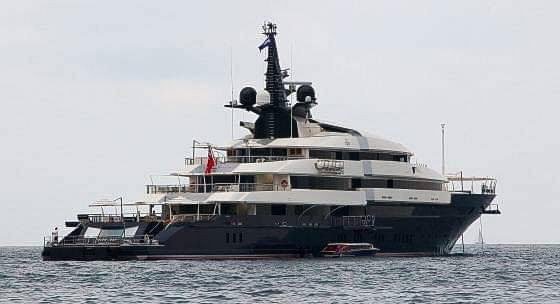
Photos courtesy of Andres Murillo
Quiet preparations for the trip had been in the works for the better part of a month, with discreet security precautions arranged and visits to Loreto by embassy personnel as well as intelligence and security personnel from both México and the United States. Although it hasn’t been confirmed, rumors have circulated that the visit was a late celebration of Michelle Obama’s birthday, January 17.
On the evening of the 20th, actor Tom Hanks and director Steven Spielberg arrived at the Loreto airport by private plane and proceeded to Loreto’s port to board a tender that took them to the Seven Seas. Later in the evening the Obamas also arrived through the private aviation section of the airport and followed the same route. A high-level shipping agency had contacted Loreto’s API Manager, Alvaro Murillo Romero, to secure permission to access the dock directly with vans, but without revealing who would be in the vans. API is Mexico’s State Integral Harbors Administrator.
Murillo greeted the special guests, along with his children. His son Andres Murillo asked former President Obama if he and Michelle would join them to pose for a photo, and Obama agreed.
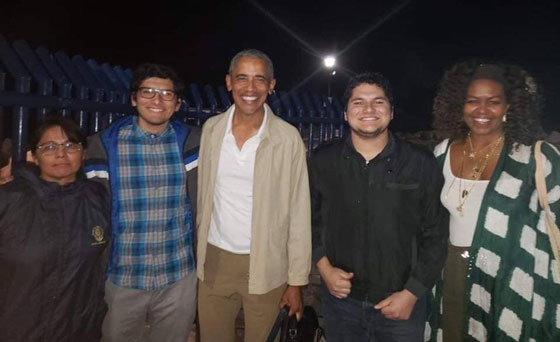
Photos courtesy of Andres Murillo
Over the next two very windy days, the Obamas spent most of their time on the yacht enjoying Loreto’s natural beauty while cruising the magnificant shoreline and islands. On January 22 they all arrived back in the port aboard one of the tenders from Seven Seas, then returned to the airport with security personnel in a motorcade of white Suburbans with blackened windows (video of the departure was posted January 22 on the Facebook page of La Mision Loreto).
The former President’s visit was a topic of interest at Eco-Alianza’s annual meeting at the end of January, with a member of the Advisory Board stating that “this was a huge deal no matter what your political persuasions are. Considering all the negative news about México that focuses on the cartels and the supposed dangers, the fact that President Obama and his Secret Service detail felt secure to take a trip like this is tremendous news. They chose Loreto out of all the many cities and towns in México, particularly coastal towns in the Sea of Cortez. This visit speaks volumes about the safety and beauty of our Loreto town.”
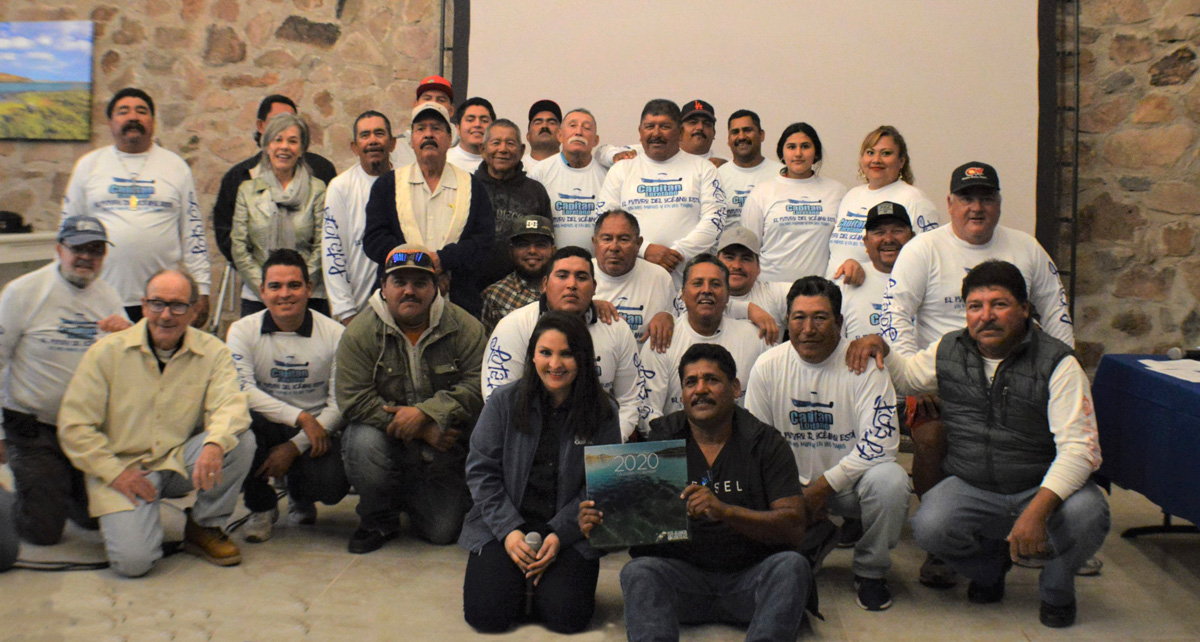
Eco-Alianza staff photo
As we described in the last issue of Soundings, Eco-Alianza is hosting regular gatherings with Loreto’s fishing community, specifically panga captains, to support and help implement the new Management Plan for the Bahía de Loreto National Park (PNBL). As part of its “One Ocean Initiative,” Eco-Alianza is engaging Loreto’s first-line service providers whose services in the sport fishing and ecotour sectors have traditionally served as a magnet for Loreto tourism. The campaign also aims to help promote the business culture and personal brand of these first-line captains – “Capitanes Loretanos.”
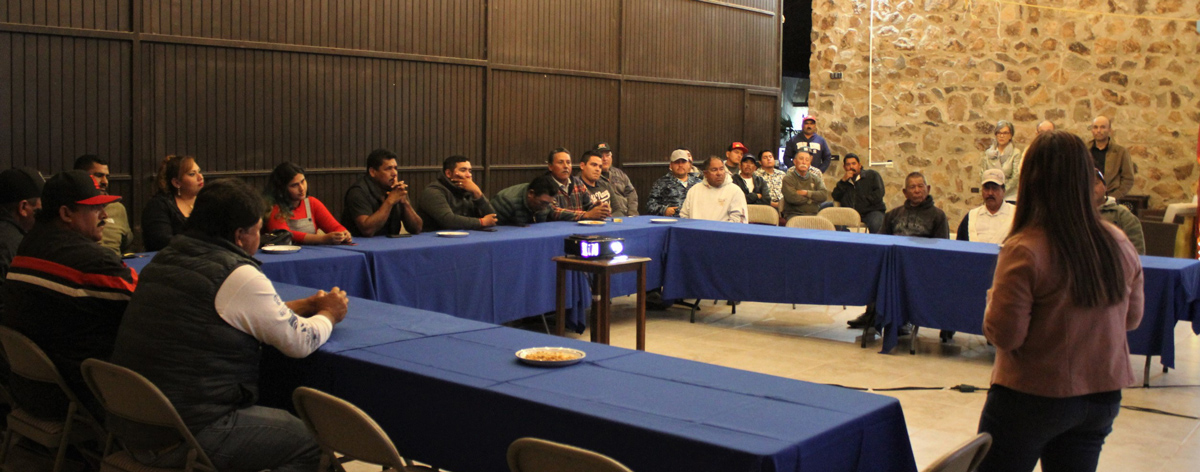
Eco-Alianza staff photo
The first meeting with this group drew 14 panga captains and included a presentation about boating safety, operations and new regulations by Loreto’s new port captain. The second meeting, December 20, drew 26 captains and a total of 40 interested parties. Both meetings also featured presentations demonstrating the online interactive map of the new zoning of the Park, developed by Eco-Alianza and available HERE, and described Eco-Alianza’s involvement also in creating durable printed maps.
The sub-zones of the new Management Plan, explained Eco-Alianza President and CEO Hugo Quintero, will work in everyone’s favor by protecting critical breeding areas and increasing biomass and biodiversity. Quintero said the success of the new management plan’s implementation will rely on the users of the Park, including the sport fishing and ecotour sector workers who are getting to know the new rules and are respectful of them. He also mentioned that Eco-Alianza will help highlight and promote the work and personal brand of the captains by means of exposing their services with marketing and communications tools, such as Eco-Alianza publishing their profiles and other information on the Loreto.com website. “Our goal and commitment supports this livelihood because it is one that strengthens the entire tourism sector in Loreto and because these individuals can be catalysts to ensure the successful implementation of the Park’s new Management Plan,” Hugo added.

Eco-Alianza staff photos
At the event Magda Gutierrez, Eco-Alianza’s communication and outreach director, presented the sleeved jersey shirts of the campaign emblazoned with the One Ocean logo. The wording on the front of the shirt is “El futuro del oceano está en mis manos y en las tuyas” (The ocean’s future is in my hands and in yours), and on the back “Juntos podemos hacer una diferencia” (Together we can make a difference).

Eco-Alianza staff photo
During the meeting, and during a complimentary supper, the captains discussed the ways they communicate with one another, specifics of what their clients are looking for, and ways in which they can work with the Park to support the stipulations of the new Management Plan. They also suggested specifics that could be helpful to include on the printed maps, developed and designed by Eco-Alianza, such as identification of marine and terrestrial fauna, information for their clients on catch limits, and information on trails, birding, and whale watching sites. Captains also discussed specifics of their profile listings on the Loreto.com website (e.g., service slogans, and areas for client reviews).
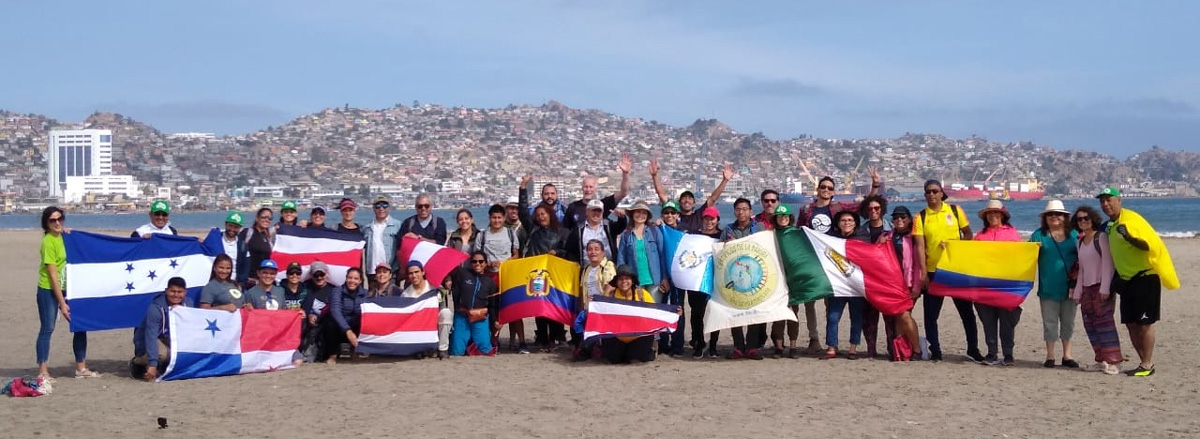
Eco-Alianza staff photo
Eco-Alianza’s Environmental Education Program Coordinator, Alma Rico, recently returned from a trip to Coquimbo, Chile, where she presented an interim report on a citizen science project she is coordinating with teachers and students at a high school in Loreto. Last June we reported on her trip to Costa Rica, where she successfully completed training workshops dealing with marine litter research. Since that time, Alma has localized the skills she learned and adapted them to explore the marine litter problem here.

Eco-Alianza staff photos
Eco-Alianza’s Communication and Outreach Director, Magda Gutierrez, interviewed Alma for Facebook last month:
MAGDA: Hello everyone, happy new year. This is our first live broadcast of 2020 and we have a special guest, our environmental educator (ALMA DELIA RICO). She has just returned from a super experience and today will tell us about it.
ALMA: Hi Magda; hello everyone nice to be here again.
MAGDA: Tell us about your experience right now.
ALMA: Well, I was on a visit to Chile participating in a collaborative research workshop. We were 34 teachers from different countries of the Pacific coast exchanging experiences, information, learning about marine litter, discussing the project that we have been developing for a whole year – talking about what is the future of this project, what do we want to happen?
MAGDA: Well, tell us which countries are participating in this research?
ALMA: Participating are: Mexico, Guatemala, Nicaragua, El Salvador, Costa Rica, Panama, Colombia, Peru, Ecuador (the Galapagos Islands — very important), and Chile is participating, of course.
MAGDA: and here in Mexico we are the only ones who are participating?
ALMA: NO! We are three institutions — high schools in Hermosillo and Ensenada and us in Loreto.
MAGDA: We in Loreto are participating with the “Modesto Sánchez Mayón” High School with the “Huella Verde” (green footprint) club with the teacher Karina (Isabel Ramírez Trevizo) and we send her regards. Tell us about this, what is this work about?
ALMA: It is a collaborative investigation, and has consisted of two previous phases and there are two more phases to begin. In the previous ones, the first was a survey. We conducted 40 surveys in a public way, the boys took to the streets and asked people, what did they think about the issue of marine litter? How did they get involved? And how much knowledge do you have? In the second phase, a sampling was carried out on the beach of Las Salinitas about biotic interactions.
Depending on the type of interactions we found — in the garbage we estimated the time it took for that garbage to be found, and how long it had been floating in the sea. All these results gave us very interesting information about our garbage — that particularly, here in Loreto the marine litter is mainly produced by ourselves. In other countries the garbage comes with the sea currents and arrives from other places, but on our beaches the garbage is mostly — well, it is ours!
MAGDA: And then talking about garbage, what is the main marine litter we find most here in Loreto?
ALMA: Looking at 150 linear meters, we found almost 500 mainly plastic objects. Some of them were glass and others were metals, but plastic is the most abundant material here and in other countries that are collaborating on the project. That is precisely the problem we want to attack, this excessive consumption of plastic that we have. We also find tangled piolas (fishing lines). We then made a call in the locality to take that into account. Knowing the results of the investigation we can work together in mitigating the problem.
MAGDA (to viewers): Friends we have already heard this is a big problem! There is a local investigation that confirms plastic really is one of the strongest problems we have in conservation, so we invite you to try to minimize its use and pay more attention to what we are doing on our beaches. Thank you very much, Alma for this interview and telling us about this research and we wish you the best of success as the investigation continues and continues for much longer.
ALMA: Thank you very much !! Thank you all.
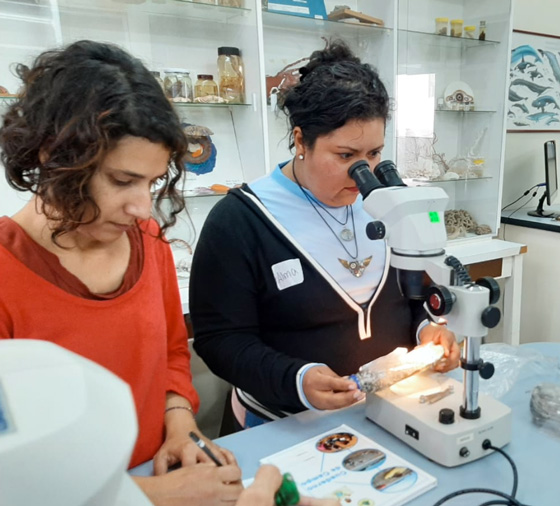
Eco-Alianza staff photo
Note: In this ongoing project, supported by the Pew Charitable Trusts, students are collaborators of the “Network of Litter Scientists,” using citizen science to deal with marine litter along the Pacific coast of Latin America. Students from different countries scientifically study marine litter to identify sources, characteristics and impacts, and from the knowledge generated by them, disseminate results and reduce marine debris in said countries. Within the network, students will be able to interact and share experiences, results and proposals, as well as co-design local action plans. By participating in this project they will develop scientific research skills that allow them to know and understand environmental problems, as well as to learn about ocean ecosystems and marine litter.
More information: http://www.cientificosdelabasura.cl/es/
![]()
“Nature Notes” is a monthly short feature detailing some of the wondrous, seasonal activities taking place around us.

Photos courtesy of Tom Haglund/BCS Birds
Photos, clockwise from top left:
Cooper’s Hawk looking quite regal resting between mad chases.
Zone-tailed Hawk just finishing its meal of some unwary bird.
Peregrine Falcon plucking an American Coot that it has already beheaded.
Another Peregrine taking a break from its role of being the fastest creature on Earth.
By Tom Haglund
Many birds that migrate from north to south in winter do so not so much to avoid the cold but because their food supply is greatly diminished by that cold. They in turn may be followed by certain flying predators that rely on them to satisfy their own appetites. One of the latter is the Cooper’s Hawk (Accipiter cooperii), also called chicken hawk and blue darter. The former because they can kill and eat a chicken, and the latter because their more regular victims are evasive flyers that require great agility on the wing to ambush or outfly. A Cooper’s Hawk in pursuit of a White-winged Dove is a dazzling display of riveted focus and lightning fast response. No matter how many zigs, zags, dips, and rolls the dove conjures, the Cooper’s stays right on the track almost as though in tow.
The Peregrine Falcon (Falco peregrinus) also follows bird migrators south in winter, but their MO isn’t about agility so much as fantastic speed and brute force. They are very clever at anticipating the escape tactics of their prey birds and cutting short their flights for freedom by getting above them and diving (stooping in the ornithologist’s jargon) at blinding speed to intersect the path of their prey and deliver a smashing and usually fatal blow at nearly 400 kilometers per hour.
A third raptor that dines on some of the birds that arrive here when the north is no longer accommodating is the Zone-tailed Hawk (Buteo albonotatus). This one’s particular trick is just that, a trick. It looks from below much like our very common Turkey Vulture, a scavenger which most small creatures learn to pretty much ignore as being harmless. The Zone-tail soars in amongst the vultures, and when it drops onto a victim, that surprised meal is usually fatally slow in realizing its mistake of letting that well-disguised eater of fresh meat so near.
Though all three of these can be here at any time of year, their numbers grow with the incoming fall bird migration and can remain large all winter.
Spanish names:
Cooper’s Hawk – Gavilán de Cooper
Zone-tailed Hawk – Agulilla Aura
Peregrine Falcon – Halcón Peregrino
Later this month we will continue Eco-Alianza’s Visiting Scientist series with a very special guest, David Borbón, a commercial fisherman from the community of El Delgadito, located on the Mexican Pacific coast within the Biosphere Reserve of El Vizcaíno. For more than eight years he undertook the challenge of recovering the red mangrove (Rhizophora mangle), and successfully achieved the reforestation of a large area in his community. His free presentation will take place February 27 at 5:30 p.m. at Eco-Alianza’s CenCoMA headquarters in downtown Loreto. Come learn more from David about the importance of preserving mangroves and our wetlands as a continuing celebration of International Wetlands Day.
Mangrove Roots Photo courtesy of Richard Jackson/Richard Jackson Photography[/content_box][content_box title=”GET YOURS NOW!” icon=”” backgroundcolor=”” iconcolor=”” circlecolor=”” circlebordercolor=”” circlebordersize=”” outercirclebordercolor=”” outercirclebordersize=”” iconrotate=”” iconspin=”no” image=”https://ecoalianzaloreto.org/wp-content/uploads/2020/01/01-Portada-copia-560.jpg” image_width=”330″ image_height=”” link=”” linktext=”” link_target=”_self” animation_type=”” animation_direction=”” animation_speed=””]2020 Calendars Going Fast
Make sure to pick up your 2020 Eco-Alianza Calendar, featuring the stunning wildlife photography of Richard Jackson. Stop by Eco-Alianza’s CenCoMA headquarters. In addition to CenCoMA, the calendar is available at Richard Jackson Gallery, Museo de Las Misiones, Hotel La Misión, Meditarráneo, Sea Coffee, El Gavilan, Geckos Curios, Tony’s Silver, Marina de Puerto Escondido, Silver Desert, Orlando’s Restaurant, Hotel Posada del Cortes and La Cholla MiniMarket (Loreto Bay).[/content_box][content_box title=”3rd Annual One Ocean Film Festival” icon=”” backgroundcolor=”” iconcolor=”” circlecolor=”” circlebordercolor=”” circlebordersize=”” outercirclebordercolor=”” outercirclebordersize=”” iconrotate=”” iconspin=”no” image=”https://ecoalianzaloreto.org/wp-content/uploads/2020/01/filmfest-JohnnyFriday.jpg” image_width=”330″ image_height=”” link=”” linktext=”” link_target=”_self” animation_type=”” animation_direction=”” animation_speed=””]Save the Dates – March 20 and 22
Join us in celebrating the Ocean with two evenings of feature films, shorts, and presentations by filmmakers. This year’s lineup includes the Loreto premiere of Sea Lion Rescue by Emmy-award-winning cinematographer Johnny Friday, who will take questions after the screening. His new film documents the efforts of dedicated naturalists and veterinarians working in the Bay of La Paz. Screenings of all films are under the stars in the Eco-Alianza courtyard, and include free popcorn! See the March/April Soundings for details on the additional films, the festival schedule, and how to buy your tickets!
Photo courtesy of Johnny Friday/Baja Productions[/content_box][/content_boxes]





